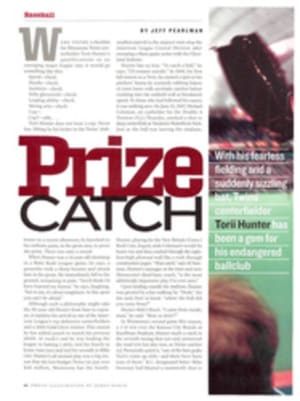
Big Play Justin Leonard putted brilliantly at the WorldCom Classic, but it was the 18-incher he missed that led to his victory
Justin Leonard is one of the Tour's best putters, so it's no
surprise that he rode a hot flat stick to his first win of 2002.
It is surprising, though, that the key to Leonard's win was his
lone bad putt of the final round, a pulled 18-inch kick-in at 14
(above) that didn't touch the cup's edge. The jab, which
resulted in a bogey and a two-shot swing that left him a shot
behind Heath Slocum, was the only putt of the day for which
Leonard didn't follow his preshot routine. It's understandable
why Leonard lost his focus: He had expended tons of mental
energy getting up and down an impressive nine times on the first
13 holes. Instead of collapsing after the miss, Leonard was
galvanized. "Walking to the 15th tee," he said, "I decided to
think about hitting the ball close to the hole and stop thinking
about what not to do."
WINNING UGLY The way Leonard won proved my favorite golf axiom:
Consistency isn't about puring 100% of your shots. It's about
making a good score no matter how you hit the ball. On Sunday,
Leonard hit only six greens in regulation, but he ground out 16
pars.
TOUGH STUFF While Leonard remained patient, his challengers grew
restless. At 13, Leonard was six up on his playing partner,
Cameron Beckman, and both of them sliced drives into the woods.
Leonard chipped out, wedged to the fringe and made bogey. Beckman
tried to run a low hummer under trees and over a bunker to an
elevated green. The shot flew into a railroad tie fronting the
green and bounced back 30 yards. He made a triple bogey.
ROLLING TO VICTORY One thing all the contenders did well on
Sunday was putt from off the green. At 15 and 18, Leonard made
critical two-putts from the fringe, while Slocum took his sole
lead of the day at 14 after draining a 25-footer that traveled
through six feet of fringe. From short grass, putting is much
better than chipping because your worst putt is always better
than your worst chip, a lesson I learned at the 1971 NCAAs. From
the 12th tee at Tucson National, I looked down an adjacent
fairway and was shocked to see Ben Crenshaw, 50 yards short of
the green, using his putter. My doubts about the Texas wedge
ended when his shot stopped 10 feet from the cup.
David Glenz runs the David Glenz Golf Academy in Franklin, N.J.,
and is one of Golf Magazine's Top 100 Teachers.
FOUR COLOR PHOTOS: COURTESY OF CBS
COLOR PHOTO: PORTER BINKS
THE TIP
Good putters use the same routine on every putt. Justin Leonard
has a great routine that lasts 45 seconds. Having already
surveyed the green from several angles, he uses most of the time
to double-check the break. Then, after brushing the putter face
with his left hand and taking a few practice strokes--the last two
with his eyes on the target--Leonard settles over the ball, peeks
at the target one more time and pulls the trigger.
Your routine should be unique and doesn't need a prescribed time
or number of steps. The routine should accomplish three things:
reading the green, determining the speed and aiming the putter
face directly at the target.
READING THE GREEN Begin gauging the green's contours while your
partners putt, and finish before addressing the ball.
SPEED CHECK A putt with perfect speed rolls to the cup's back
edge but not past it. To gauge speed, I keep my eyes on the
target--not on the ball--while making a few practice strokes. My
favorite speed drill: Put three balls on a green, each a
different distance from a coin (not a hole), and try to stop each
ball at the coin.
AIMING The key is to meticulously align the putter to the
target--not necessarily the hole--before getting into the
address position.

